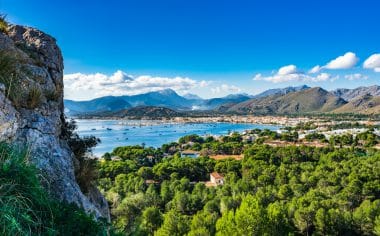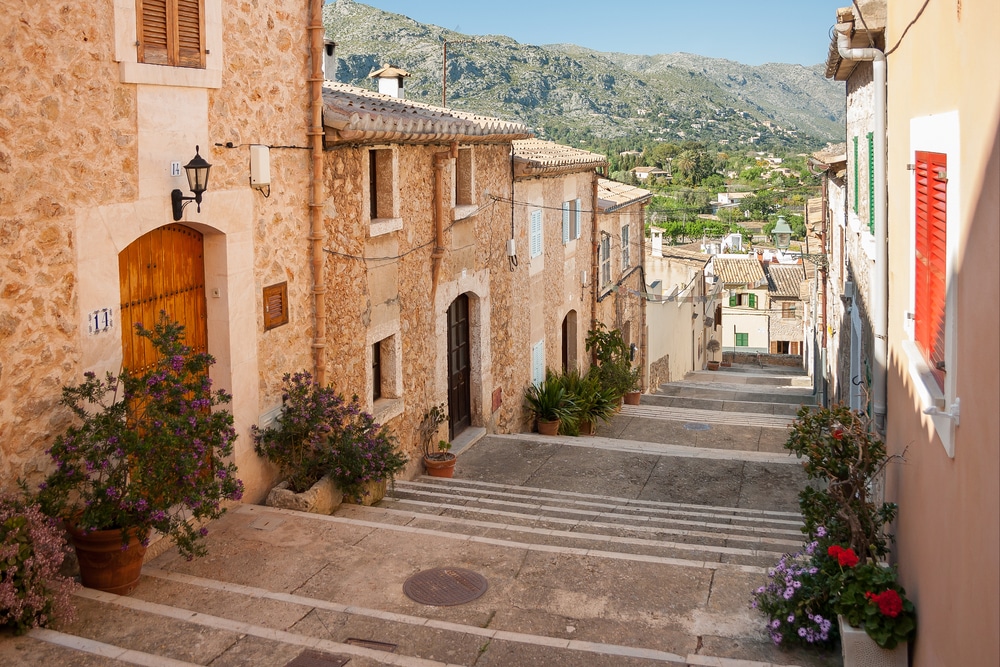Mallorca’s northeast is not free of surprises… Located in the northernmost part of the Serra de Tramuntana, the town of Pollenca is one of the most atmospheric on the island.
Where the mountain range and the sea meet, on a wide curving Mediterranean bay, the town invites you to stroll with its winding streets, picturesque natural stone houses and important art treasures.
And yet the country town is quite idiosyncratic. With a dozen art galleries and the annual international music festival, Pollenca stands out from the rest of the provincial towns. In addition, the mostly wealthy Pollencin residents cultivate their own dialect and traditional crafts.
You can tell that the town with its port offshoot Port de Pollenca is a special place. A place for lovers of beauty, a place for Mallorca connoisseurs.
A look at the history book reveals: Several megalithic buildings prove that people settled in the area as early as the Bronze Age. It dates back to Roman times, which is still well
bridge over the Torrent de Sant Jordi on the northern edge of Pollenca. The proximity of the Roman city of Pollentia (near today’s Alcudia) brought prosperity, but this soon dried up due to the vandal storms of the 5th century. The really big time dawned with the Moors, who transformed the valley into a lush garden with their water pumping technology. After the Christian reconquest, churches and monasteries were built.
Arrive & look around
Here, where the cliffs fall 200 metres deep into the Mediterranean Sea and a road boldly carved into the rock winds over 18 kilometres from Port de Pollenca to the lighthouse of Mallorca’s northeastern tip, built in 1892, the town of Pollenca spreads its very own flair: its location and atmosphere make it something special – Pollenca is a Mallorcan work of art.
Between heavenly realms and earthly pleasures
Two hundred and sixty-five steps lead to the Calvary in the shade of dark cypresses. The road struggles upwards in narrow serpentines – twelve large stone crosses testify to the importance of this hill. Via the Stations of the Cross you finally reach the small pilgrimage church with the large view. This view of the town, the Puig de Maria opposite, up to the two bays of Pollenca and Alcudia is just as stunning as the one on the stairway mountain of the “calvari” – as ochre-coloured and cypress-lined as the houses of the town.
Must see! Active and creative in the pretty artists’ town of Pollenca….
A visit to the Casa Museum Dionis Bennassár on Roca 14 is worthwhile. In the house of the artist Dionis Bennássar (1904-1967), 240 of his works are exhibited. The artist belonged to the group around the Art Nouveau painter Hermenegildo Anglada Camaraca.
Others end up in Puig de Maria, the city’s local mountain, crowned by the former nunnery Mare de Déu del Puig. Just behind the last houses of the monastery complex, the path leads to an old pilgrimage path. From there, there is a stunning view.
Tip: a stop at the Klosterstübchen compensates for a rather arduous ascent.
Attention festival fans! The popular international music festival takes place every year in August in the courtyard of the Dominican monastery, framed by the cloister. In winter, Mallorcan folklore is offered here on Sundays. In addition, the monastery houses an old people’s home as well as the local history museum.
Water rats, sun worshippers and water sports enthusiasts also get their money’s worth: They all cavort at Cala de Sant Vicenc, located northeast of Pollenca. The beach area is framed by a 300-metre-high rock face in the east.

And finally you reach Port de Pollenca, a “fishing village where you live as life should be, simple and content” …., according to the journalist Gordon West in 1929 on his trip to Mallorca!
Here you walk under ancient pine trees, past beautiful villas and hotels from the Wilhelminian period. Three local areas invite you to linger:
- A wide sandy beach that stretches several hundred meters from the southern entrance to the village to the extensive facilities of the marina and fishing port.
- Followed by the old town centre with the tree-lined Plaza Miguel Capllonch,
- And last but not least, the highlight…., the Passeig Vora Mar with the extension Carrer Colon. This magnificent footpath and cycle path runs for almost 2 kilometres along small shady stretches of beach, past old villas. Almost at the end is the Illa d’Or, the beautifully located (and most expensive) hotel in the town with one of the best restaurant terraces in Mallorca.
But that’s not all! The old fishing village is the hotspot for water sports enthusiasts: For surfers, sailors, kayakers and yacht owners, a paradise is revealed. On the beach by the harbour there is white sand, plenty of space and extensive service.
Pollenca is a lively tourist resort with a rich offer of sports and entertainment. The charming town at the foot of high mountains is undoubtedly one of the most interesting cities on the whole island. The white bay is ideal for windsurfing. In the alleys of the former fishing village, you can still feel the atmosphere that attracted wealthy Britons as early as the 1930s. The fine sandy beaches around the village and the beautiful promenade still inspire.
Don’t miss it! Enjoyment in the most beautiful places – tips for a cosy stop
There are a number of good restaurants near the harbour and on the quay of Port de Pollenca. The typical Mallorcan restaurant Bona Cepa near the harbour and a visit to the bar “Sail & Surf” for a cold beer can be particularly recommended.
No less inspiring is the “Argos”, conspicuous by its simple decoration. There’s nothing to distract from the creative Mediterranean cuisine here – except perhaps the sea view.
It doesn’t get any greener than this: The restaurant of the Pension Bellavista offers the perfect setting for the creative vegetarian recipes – heavenly delights in a magical ambience.


